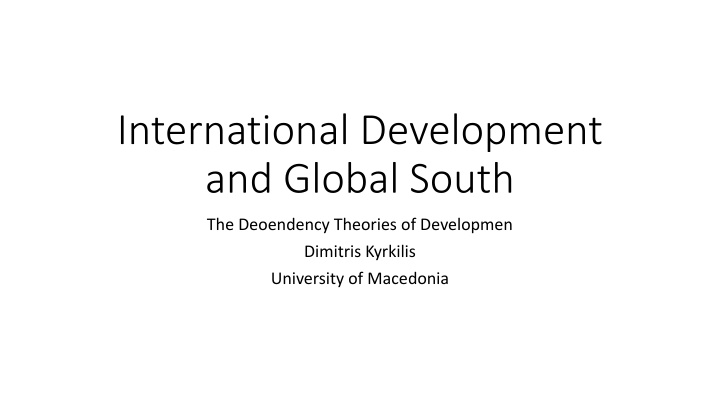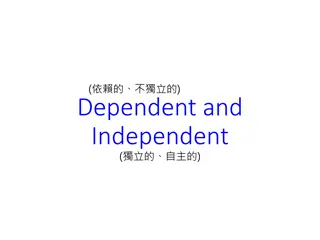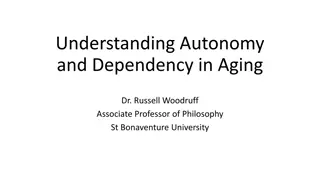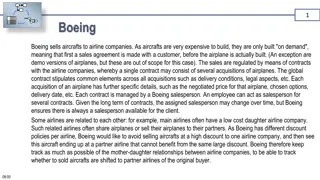
Dependency Theories of Development in Global South
Explore the Dependency Theories of Development in the Global South, focusing on the radical approach and insights from economist Theotonio Dos Santos. Understand how developing countries face constraints due to dependency relationships with developed nations, impacting their development strategies and underdevelopment challenges.
Download Presentation

Please find below an Image/Link to download the presentation.
The content on the website is provided AS IS for your information and personal use only. It may not be sold, licensed, or shared on other websites without obtaining consent from the author. If you encounter any issues during the download, it is possible that the publisher has removed the file from their server.
You are allowed to download the files provided on this website for personal or commercial use, subject to the condition that they are used lawfully. All files are the property of their respective owners.
The content on the website is provided AS IS for your information and personal use only. It may not be sold, licensed, or shared on other websites without obtaining consent from the author.
E N D
Presentation Transcript
International Development and Global South The Deoendency Theories of Developmen Dimitris Kyrkilis University of Macedonia
Radical Approach to Development Radical Approach to Development The Depenency theories of Development consider that the developing countries face constraints imposed by the global political and economic order in their attempt to develop. These constraints are mainly pertained to the fact that the less developed countries are dependent on the developed ones. The latter use this relation of dependency for exploiting the less developed countries and extracting rents from them. It is exactly this relatioship of dependency and exploitation that causes underdevelopment. Development strategies should focus on employment creation, reduction of poverty, and elimination of income inequality.
Theotonio Dos Santos Theotonio Dos Santos By dependence we mean a situation in which the economy of certain countries is conditioned by the development and expansion of another economy to which the former is subjected. The relation of inter-dependence between two or more economies, and between these and world trade, assumes the form of dependence when some countries (the dominant ones) can expand and can be self- sustaining, while other countries (the dependent ones) can do this only as a reflection of that expansion, which can have either a positive or a negative effect on their immediate development. Dos Santos, 1970, The Structure of Dependency, American Economic Review, 60(2): 231 36 Dependence is a conditioning situation in which the economies of one group of countries are conditioned by the development and expansion of others. A relationship of interdependence between two or more economies or between such economies and the world trading system becomes a dependent relationship when some countries can expand through self-impulsion while others, being in a dependent position, can only expand as a reflection of the expansion of the dominant countries, which may have positive or negative effects on their immediate development. In either case, the basic situation of dependence causes these countries to be both backward and exploited . Dos Santos, 1973, The Crisis of Development Theory and the Problem of Dependence in Latin America , in H. Bernstein (ed.) Underdevelopment and Development: The Third World Today, pp. 57 80. Harmondsworth: Penguin Books.
Theotonio Dos Santos Theotonio Dos Santos Dos Santos clarifies that in the dialectical relations between the dominant and the dependent countries, that is between the external and internal factors, the process of capital accumulation of the dependent countries is conditioned by their insertion in the world economy while at the same time being determined by their own internal laws of development (Dos Santos, T. (1991) Democracia e Socialismo no Capitalismo Dependente [Democracy and Socialism in Dependent Capitalism]. Petropolis: Editora Vozes.) It is about analysing dependency not only as an external factor that limits economic development, but as something that makes up a certain type of social structure whose legality or dynamism is given by the condition of dependence. By defining dependence as the mode of operation of our societies, this concept has been placed as a fundamental explanatory concept of the condition of underdevelopment, Dos Santos, T. (1968) The Changing Structure of Foreign Investment in Latin America , in J. Petras and M. Zeitlin (eds) Latin America: Reform or Revolution?, pp. 94 98. New York: Fawcett.
Paul Prebisch: Centre Paul Prebisch: Centre - - Periphery Periphery What transpires from these definitions is the central idea of an interdependent world system, shadowing Prebisch s idea of the centre periphery system (ECLA, 1951, Economic Survey of Latin America 1949, New York:United Nations Economic Commission for Latin America ; Kay, C. ,2019, Raul Prebisch (1901 1986) , in D. Simon (ed.) Key Thinkers on Development, pp. 339 45. London: Routledge) in which a certain international division of labour dictates that the centre countries industrialize and develop through the export of industrial commodities while the periphery countries are largely confined to the production and export of primary commodities based on the exploitation of their natural resources.
Transfer of Surplus to the Centre Transfer of Surplus to the Centre Both Dos Santos and Prebisch characterize this as an unequal trading system in which the periphery (or dependent countries in Dos Santos s terminology) transfer an economic surplus to the centre (or dominant countries). Prebisch explains this transfer of surplus as arising from the periphery s deterioration of the terms of trade, in terms of the evolution of the price of primary commodities exported by the periphery countries and imported by the centre countries, as compared to the price of industrial commodities exported by the centre and imported by the periphery. Dos Santos also includes other transfers such as those arising from profit remittances, transfer pricing, royalty payments, high interest payments for servicing foreign debt, and payments for other services commn in studies on imperialism.
Unequal Exchange Unequal Exchange In later publications Dos Santos also introduces the Marxist concept of unequal exchange derived from the analysis of Arghiri Emmanuel (1972) Unequal Exchange: A Study of the Imperialism of Trade. New York and London: Monthly Review Press. this is rooted in the Marxist labour theory of value and hence is not confined to the production and export of raw materials by the periphery, as in Prebisch s analysis, but also arises in the export of industrial commodities as well as services from the dependent to the dominant countries. However, P. Prebisch (1950) The Economic Development of Latin America and its Principal Problems. New York: United Nations; and P. Prebisch (1964) Towards a New Trade Policy for Development. Report by the Secretary General of UNCTAD. New York: United Nations refer to the existence of surplus labour in the periphery as leading to a low-wage economy which is one of the reasons for the deterioration of the periphery s terms of trade, as well as for unequal exchange, foreshadowing elements of Arthur Lewis s famous analysis on unlimited supplies of labour and terms of trade published in 1954.
Structuralist Structuralist Approach to Dependency Approach to Dependency Paul Prebisch and the ECLA team (key representatives of the structuralist version of Dependency Theory, Osvaldo Sunkel, Celso Furtado, Kay, and Fernando Henrique Cardoso, all of whom had worked, at one time or another, in ECLA or associated institutions) founded the dependency theory. ECLA emphasised the historical and structural features which had shaped the development process of Latin America (and other periphery regions of the world) since the colonial period, as distinct from the economic (and socio-political structures) which had emerged since the industrial revolution in the centre or developed countries (O. Sunkel, 1966, The Structural Background of Development Problems in Latin America , Weltwirtschaftliches Archiv 97(1): 22 63; and O. Sunkel, and P. Paz, 1970, El Subdesarrollo Latinoamericano y la Teor a del Desarrollo [Latin American Underdevelopment and the Theory of Development]. Mexico City: Siglo Veintiuno Editores. Latin America had to find its own development strategy and path as structures and circumstances differed compared to those of the centre.
Import Substitution Industrialisation Import Substitution Industrialisation Prebisch argued in favour of the industrialisation of Latin America which required protectionism, as well as other supportive measures from the state for promoting an import substitution industrialisation. ECLA structuralists, later became critical of the way the import substitution industrialisation (ISI) strategy was being implemented by governments. After an initial phase of rapid industrial growth during the 1950s and early 1960s the process became exhausted to use ECLA s phrase. One of the reasons for this slowdown was the foreign exchange bottleneck which had developed as imports rose faster than exports. As ISI proceeded it required increasing imports of intermediate goods (various inputs) as well as of capitals goods (machinery, tools, spare parts) while exports did not rise fast enough to generate the required foreign exchange. Hence, the imports of these goods became more expensive and were being rationed, affecting industrial investment and leading to lower rates of growth. Furthermore, the expectations of employment generation and improvement in the highly unequal income distribution were disappointing.
The Marxist Approach to Dependency For the Marxist version of Dependency Theory, besides Theotonio Dos Santos the key original contributor was Andre Gunder Frank. Dos Santos discovered the increasing penetration of foreign capital, mainly from US multinationals, into Latin America s industrial sector. While in the past foreign investors, to a greater or lesser extent, had invested in mining and some plantations, mainly for export, they now began to direct their investment to the industrial sector by establishing subsidiaries so as to retain access to the domestic market as they now had to face protective barriers for the export of their manufactures. As a consequence of the ISI strategy, industry became the most dynamic sector of the economy in the initial phase. Thus foreign capital gained an increasing level of control over the national economy through this process of denationalization.
National bourgeoisies associated their interests to National bourgeoisies associated their interests to the interest of foreign bourgeoisies the interest of foreign bourgeoisies The national bourgeoisie welcomed foreign capital and associated its interests with those of the foreign bourgeoisie, who were the main domestic beneficiaries. Dos Santos castigated the national bourgeoisie for becoming subservient to foreign capital. Hence, for Marxists, the new industrial bourgeoisie was seen as abdicating its historically progressive role. It was this new incursion and dominance of foreign capital and its impact on the country s economy, society and polity that Dos Santos labelled the new character of dependence .
New Imperialism New Imperialism Dos Santos was concerned that a large proportion of industry s economic surplus was transferred abroad to the country of origin of the multinationals, thereby limiting the process of capital accumulation and economic growth. He interpreted this situation through recourse to the Marxist theory of imperialism and particularly to the writings of Vladimir Lenin, Rosa Luxemburg and Nikolai Bukharin, as well as the non-Marxist John Hobson. Dos Santos believed that a distinct form of capitalism developed within the dominated countries through particular transformations of the colonial countries brought about by their incorporation into the sphere of the imperialist countries.
Technological Dependence It is common to observe in the process of industrialization in the advanced capitalist countries that there is a certain sequence, from the production of consumer goods to the production of intermediate and capital goods, as a result of the various linkages between them. The cycle of capital accumulation in dependent countries cannot be completed internally as they have only an incipient and simple capitals goods sector. Traditionally, most, if not all, of the equipment, tools and machinery for the extraction of the natural resources are imported from the dominant countries. With ISI, dependent countries need to import the required capital and intermediate goods for developing their industrial sector. In order to achieve sustainable economic growth and higher living standards, a country cannot rely solely on using more land, labour and capital but has to increasingly rely on raising the productivity of these three factors of production by introducing advanced technologies and developing its own capital goods sector. As the Latin American countries had not yet been able to develop such a capital goods sector they had to import the machinery and related tools from the dominant countries, allowing the latter to acquire an even greater stranglehold over their economies. In short, one of the key characteristics of dependency is that the dependent countries lack the capacity for autonomous and self-sustaining growth as the realization of their investment cycle requires, to a greater or lesser extent, the import of capital goods and hence cannot be achieved domestically.
The Potential of Emancipation The Potential of Emancipation If the dependent economies can obtain a high degree of productive autonomy and develop an important secto of machines and industrialized raw materials, foreign capital would lose its capacity to determine the character of its development, it would turn into a purely artificial expression which would soon be destroyed, terminating the dependence relationship. This potential path for the disappearance of dependency is blocked by transnational capital as the foreign multinationals shift their consumer goods industries to the dependent countries and block the establishment of domestic capital goods industries so as to retain their control over technology. This has deleterious implications for technological progress and growth in the dependent countries. Thus it is the political influence and power of transnational capital (or neo-imperialism, as some refer to it) which blocks this liberating possibility for dependent countries.
What about NICs? What about NICs? However, the development experiences of some of the newly industrializing countries (NICs), such as South Korea and Taiwan, seem to contradict this view. Dos Santos ignored the case of NICs which were seen by dependentistas or dependists as mere export platforms for industrial consumer goods, taking advantage of their cheap labour. This was partly the case in the first phase with the creation of industrial export zones, largely in coastal areas, which had few linkages with the domestic economy.
Political Dilemma: Socialism or Fascism Political Dilemma: Socialism or Fascism Given the transfer of part of the economic surplus via unequal exchange to the dominant countries, the domestic capitalist class resorted to super-exploiting its labour force, either by prolonging the working day or by intensifying the work process, so as to protect its profits and remain competitive in international markets As the ISI process advanced, the requirements for accumulation increased as industries became more capital intensive thereby pushing the capitalist class to squeeze more surplus value from labour. This only exacerbated social conflicts leading to the dilemma mentioned so starkly by Dos Santos: socialism or fascism.
World Systems Theory World Systems Theory The world systems theory, developed by sociologist Immanuel Wallerstein, is an approach to world history and social change that suggests there is a world economic system in which some countries benefit while others are exploited. Just like we cannot understand an individual's behavior without reference to their surroundings, experiences, and culture, a nation's economic system cannot be understood without reference to the world system of which they are a part. The world systems theory is established on a three-level hierarchy consisting of core, periphery, and semi-periphery areas. The core countries dominate and exploit the peripheral countries for labor and raw materials. They are strong in military power and not dependent on any one state or country. They serve the interests of the economically powerful. They are focused on higher skill and capital- intensive production. Core countries are powerful, and this power allows them to pay lower prices for raw goods and exploit cheap labor, which constantly reinforces the unequal status between core and
Core vs. Centre Core vs. Centre The term core suggests a multicentric region containing a group of states rather than the term centre, which implies a hierarchy with a single peak. The first core region was located in northwestern Europe and made up of England, France, and Holland. Today, the United States is an example of a core country. The U.S. has large amounts of capital, and its labour forces are relatively well paid.
Peripheral and Semi Peripheral and Semi- -peripheral peripheral The peripheral countries are at the bottom, mainly in Africa, which provide the raw materials such as cash crops to the core and semi periphery. These are also the emerging markets in which the core attempts to market their manufactured goods. The semi-peripheral countries share characteristics of both peripheral and core countries. The semi-peripheral zone includes countries like South Africa or Brazil which resemble the core in terms of their urban centres but also have areas of rural poverty which resemble the peripheral countries. The core contracts work out to these countries.
Country mobility in the hierarchical order Country mobility in the hierarchical order Countries can be upwardly or downwardly mobile in the world system. This is one of the key differences between World System s Theory and Frank s Dependency Theory. Many countries, such as the BRIC nations have moved up from being peripheral countries to semi-peripheral countries. However, most countries do not move up and stay peripheral, and the ex- colonial powers (the wealthy European countries) are very unlikely to slip down the global order. The Modern World System is dynamic core countries are constantly evolving new ways of extracting profit from poorer countries and regions.
The first world system: Capitalism The first world system: Capitalism World-systems are larger, and are ethnically diverse. The modern world-system, a capitalist world-economy, is unique in being the first and only world-system, which emerged around 1450 to 1550, to have geographically expanded across the entire planet, by about 1900. World-systems analysis argues that capitalism, as a historicalsystem, has always integrated a variety of labor forms within a functioning division of labor (world economy). Countries do not have economies but are part of the world economy.
World System: Definition World System: Definition A world-system is what Wallerstein terms a "worldeconomy", integrated through the market rather than a political center, in which two or more regions are interdependent with respect to necessities like food, fuel, and protection, and two or more polities compete for domination without the emergence of one single center forever A world-system is a "multicultural terirtorial division of labor in which the production and exchange of basic goods and raw materials is necessary for the everyday life of its inhabitants." This division of labour refers to the forces and relations of production of the world economy as a whole and it leads to the existence of two interdependent regions: core and periphery. These are geographically and culturally different, one focusing on labor-intensive, and the other on capital-intensive production. The core-periphery relationship is structural. Semi-peripheral states acts as a buffer zone between core and periphery, and has a mix of the kinds of activities and institutions that exist on them.
Operation of the world system Operation of the world system Technology is a central factor in the positioning of a region in the core or the periphery. Advanced or developed countries are the core, and the less developed are in the periphery. Peripheral countries are structurally constrained to experience a kind of development that reproduces their subordinate status. The differential strength of the multiple states within the system is crucial to maintain the system as a whole, because strong states reinforce and increase the differential flow of surplus to the core zone. This is what Wallerstein called unequal exchange, the systematic transfer of surplus from semiproletarian sectors in the periphery to the high-technology, industrialized core. This leads to a process of capital accumulation at a global scale, and necessarily involves the appropriation and transformation of peripheral surplus. On the poltical side of the world-system, for Wallerstein, nation-states are variables, elements within the system. States are used by class forces to pursue their interest, in the case of core countries. Imperialism refers to the domination of weak peripheral regions by strong core states. Hegemony refers to the existence of one core state teomporarily outstripping the rest. Hegemonic powers maintain a stable balance of power and enforce free trade as long as it is to their advantage. However, hegemony is temporary due to class struggles and the diffusion of technical advantages. Finally, there is a global class struggle. The current world-economy is characterized by regular cyclical rhythms, which provide the basis of Wallerstein's periodization of modern history. After our current stage, Wallerstein envisions the emergence of a socialist world-government, which is the only-alternative world-system that could maintain a high level of productivity and change the distribution, by integrating the levels of political and economic decision-making.
Globalisation Theory Globalisation Theory Through the process of globalization, the assumption is that more nations are depending on worldwide conditions in terms of communication, the international financial system, and trade. Therefore the world scenario is more integrated in international economic transactions. Effects and influences from these "integrational aspects" can be studied from two major perspectives: (a) countries external level -or systemic approach-; and (b) domestic or internal conditions within nations -sub-systemic approach. In this last mentioned case, the units of analysis will be those corresponding to national variables of economic growth, or social indicators.
Global System of Interaction Global System of Interaction The globalisation approach suggests that the structure of the global system, and the roles that countries play within the international division of trade and labour, is crucial in understanding a wide array of social, political, and economic changes within particular countries. International connections, roles, and relationships are important variables in any analysis which tries to explain various dimensions of development -economic growth, for example- trade, financial links and communications among countries. The fundamental premise of globalisation is that an increasing degree of integration among societies plays a crucial role in most types of social and economic changes. This premise is widely accepted. However, there is much less consensus on its fundamental organising principles and laws of motion. Neoclassical economic theories are based on comparative advantage, international relations approaches stress geopolitics, and world-systems perspectives emphasise "unequal exchange" offering contrasting models of the international system.
Elements of Globalisation Elements of Globalisation In addition to the technological, financial and political ties, globalization scholars argue that modern elements for development interpretation are the cultural and economic links among nations. In this cultural communication, one of the most important factors is the increasing flexibility of technology to connect people around the world. The main aspects of the theory of globalization can be delineated as follows: a) Global communications systems are gaining an increasing importance every day, and through this process all nations are interacting much more frequently and easily, not only at the governmental level, but also within the citizenry; b) Even though the main communications systems are operating among the more developed nations, these mechanisms are also spreading in their use to less developed nations. This fact will increase the possibility that marginal groups in poor nations can communicate and interact within a global context using the new technology, and therefore can integrate themselves with the "global village", which represents the current scenario in worldwide communications and transactions
Elements of Globalisation continued Elements of Globalisation continued c) In terms of economic activities, the new technological advances in communication are becoming more accessible to local and small businesses. This situation is creating a completely new environment for carrying out economic transactions, utilizing productive resources, equipment, trading products, and taking advantage of "virtual monetary mechanisms." From a cultural perspective, the new communication products are unifying patterns of communications around the world, at least in terms of economic transactions under current conditions; d) The concept of minorities within particular nations is being affected by these new patterns of communication. Even though these minorities are not completely integrated into the new world system of communications, the powerful business and political elites in each country are a part of this interaction around the world. Ultimately, the business and political elite continue to be the decision makers in developing nations; e) Social and economic elements under the influence of the current phenomenon of globalization are determinant circumstances which affect the standards of living of every particular nation.
Main features of globalisation Main features of globalisation Globalization, thus, has powerful economic, political, cultural and social dimensions: de-localization and supraterritoriality; the speed and power of technological innovation and the associated growth of risk; the rise of multinational corporations; and the extent to which the moves towards the creation of (global) free markets to leads to instability and division.
International production International production In the last thirty years or so of the twentieth century, a new economy emerged around the world. It is perhaps a new brand of capitalism built around international production. Productivity and competitiveness are, by and large, a function of knowledge generation and information processing; firms and territories are organized in networks of production, management and distribution; the core economic activities are global that is, they have the capacity to work as a unit in real time, or chosen time, on a planetary scale. https://infed.org/mobi/globalization-theory-and-experience/






















